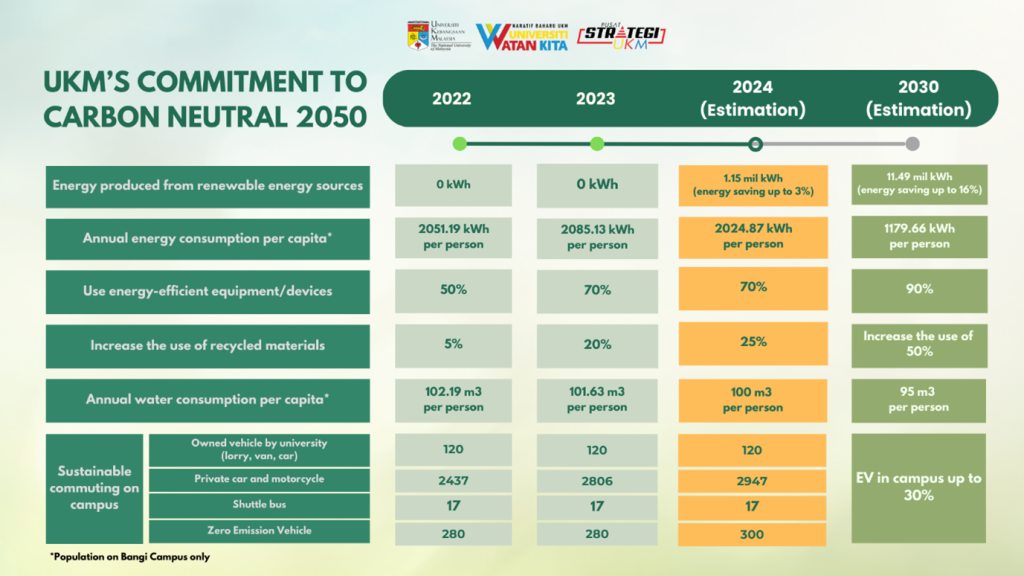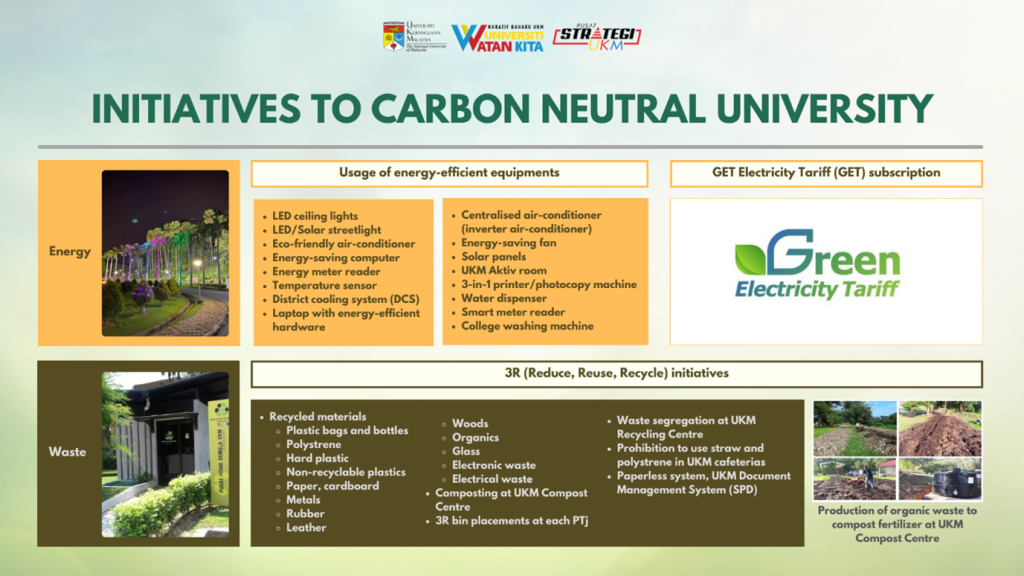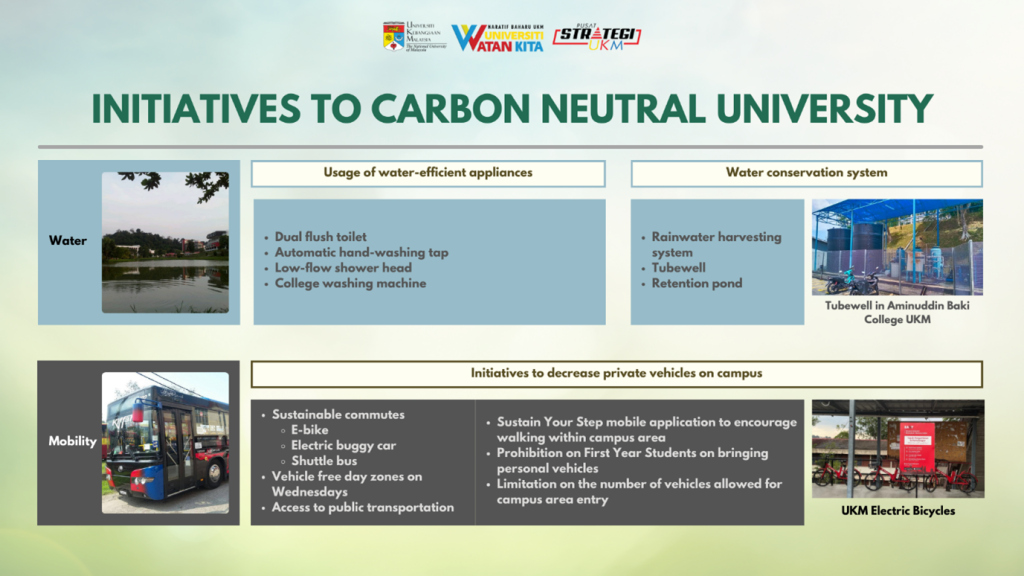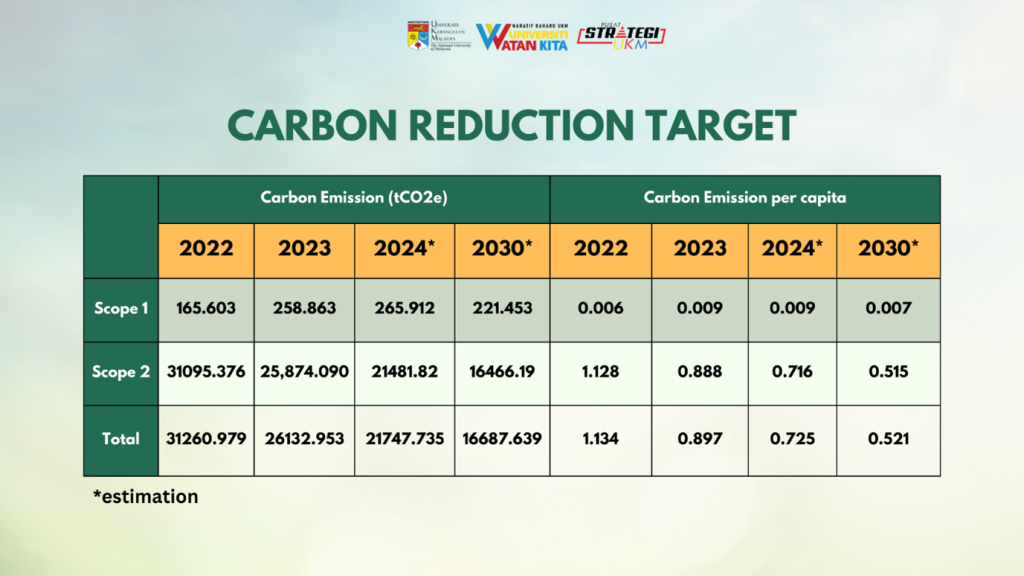UKM’s Net Zero Emission Target 2050
UKM has started a Carbon Tracking Program on campus starting in 2022. This initiative is in line with the university’s desire to create a sustainable campus as stated in the UKM 2030 Sustainability Strategic Plan. This program applies the methodology prescribed by the GHG Standard Protocol for reporting greenhouse gas emission rates. UKM’s objective is to progressively decrease the carbon emission rate within the campus by 2030, with a broader, long-term aim of achieving a carbon-neutral status by 2050.
To attain this goal, UKM implements a range of initiatives aimed at diversifying sustainability efforts, which encompass activities like tree planting programs and forest reserve conservation program. These endeavours are considered essential as part of UKM’s strategy to offset carbon emissions by the UKM Forest Reserve in Bangi.
Moreover, UKM has taken steps to reduce electricity consumption on its campus through two main strategies. These strategies involve the gradual conversion of energy-efficient equipment and the introduction of measures to harness renewable energy sources, such as solar power, within the campus premises.
UKM_NET_ZERO_EMISSION_TARGET_2050UKM’s Initiatives Towards Net Zero Emission Target 2050
UKM_INITIATIVES_TOWARDS_NET_ZERO_EMISSION_TARGET_2050UKM’S Greenhouse Gas Emissions and Commitment Towards Carbon Neutral 2050
In adherence to achieving a sustainable campus, UKM has commenced a Carbon Tracking Program on 2022. This initiative aligns with the university’s desire to create a sustainable campus as stated in the UKM 2030 Sustainability Strategic Plan. UKM designed a process flowchart to calculate GHG emissions (Figure 1). This program applies the methodology prescribed by the GHG Standard Protocol for reporting greenhouse gas emission rates (Figure 2). The adopted methodology facilitates the calculation of Scope 1, 2 and 3 emissions as delineated by the GHG Protocol, providing a comprehensive assessment of UKM’s on-campus GHG footprint.

Figure 1: The process flow diagram for implementing UKM’s carbon accounting and reporting


Figure 2: GHG Protocol procedure and methodology used for calculating and reporting carbon emission in UKM
The combined emissions from both Scope 1 and Scope 2 were determined to be 26,132,952.85 kgCO2e (26,132.953 tCO2e). Figure 3 visualizes UKM’s greenhouse gas emissions by scope. Details on the methodology used for calculations and a further breakdown for each scope can be found below.

Figure 3: Scope 1 and 2 emissions in UKM, for year 2023
Calculation on Scope 1, 2 and 3 Emissions
Scope 1 Emissions
Calculating Scope 1 emissions, which encompass those directly generated by university-owned or controlled sources like vehicles, required additional effort. Since data wasn’t centralized, UKM distributed a survey to gather information on vehicle mileage, commuting distances, and fuel usage of the UKM citizens. This data, combined with the total number of registered vehicles obtained from UKM Security Division (2022/2023 data), allowed us to estimate the average fuel consumption for UKM and subsequently calculate total emissions from university vehicles.
Calculation for Scope 1
We have calculated our scope 1 emission from the year 2023. The total emissions for Scope 1 emission were calculated based on the following equation:
- Emissions (kgCO2e) = Quantity of Fuel Consumed (L or kg) × Emission Factor (kg CO2e per L or kg)
The emission factor used for calculating fuel combustion for both diesel and petrol are sourced from IPCC as follows:
- Diesel: 2.70533 kgCO2e/litre
- Petrol: 2.33969 kgCO2e/litre
Based on the calculations, UKM’s total Scope 1 emissions in 2023 were 258,863.122 kgCO2e (258.863 tCO2e).
Scope 2 Emissions
Scope 2 emissions originate from the indirect greenhouse gases released during the generation of electricity purchased from external sources. This category encompasses emissions associated with the consumption of purchased electricity, heat, steam or cooling. At UKM, data on electricity consumption, including that used by district cooling system are mainly collected from utility bills provided by the energy supplier, which is Tenaga Nasional Berhad (TNB). Energy Management Department (JPT) under Infrastructure Development Department (Prasarana UKM) centrally manages these bills which details monthly electricity use. This data on energy consumption is vital for precise Scope 2 emission calculations.
Calculation for Scope 2
The Scope 2 emissions were calculated using data obtained from 2023. The total emissions for Scope 2 were calculated based on the following equation:
- Emissions (kg CO2e) = Total kWh Consumed × Emission Factor (kg CO2e per kWh)
The emission factor used for calculating energy emissions are sourced from IPCC as follows:
- Electricity grid : 0.4362 kgCO2e/kWh
- District cooling : 0.3926 kgCO2e/kWh
The total calculated greenhouse gas emissions for Scope 2 in 2023 is 25,874,089.73 kgCO2e (25,874.090 tCO2e). Figure 4 illustrates the monthly emissions produced from electricity consumption in UKM for the year 2023.

Figure 4: Monthly Scope 2 emissions in UKM, for year 2023
Scope 3 Emissions
Scope 3 involves a wider range of categories compared to Scopes 1 and 2, making data collection more complex. Unlike Scopes 1 and 2, which focus on direct and purchased energy emissions, Scope 3 encompasses all the indirect greenhouse gas (GHG) emissions that occur throughout an organization’s value chain, for instance waste disposal, water consumption, commuting, business travel and procurement. Therefore, for 2023, we have estimated Scope 3 emissions to be 75,706.53 tCO2e, based on the previous year’s data. This approach will be revisited as we secure additional resources for a more thorough evaluation. Figure 5 shows the elements considered for Scope 3 emissions accounting within UKM.

Figure 5: Elements considered for Scope 3 emissions accounting in UKM
Commitment and Initiatives Towards Carbon Neutral University
UKM is on a path to carbon neutrality by 2050. Our roadmap includes a significant reduction in on-campus carbon emissions by 2030. To get there, UKM is implementing a comprehensive sustainability strategy targeting all emission scopes (1, 2, and 3). This multi-faceted approach minimizes our environmental impact across the entire university. Figure 6 to Figure 9 outline UKM’s ongoing efforts to achieve Net Zero by 2050.

Figure 6: Climate change policy formulation and carbon neutral target

Figure 7: UKM’s Carbon Neutral Roadmap

Figure 8: UKM’s commitment to carbon neutral 2050


Figure 9: UKM’s initiatives to carbon neutral University
Carbon Reduction Target
UKM’s Carbon Tracking Program, which commenced in 2022, has been measuring the university’s greenhouse gas emissions following the GHG Protocol standard. We use these calculations to estimate future emissions, including projections for 2024 and 2030, in order to track our progress towards achieving carbon neutrality by 2050. Figure 10 shows the carbon reduction target for UKM up to the year 2030.

Figure 10: Estimated emissions to monitor progress towards a carbon-neutral future by 2050
